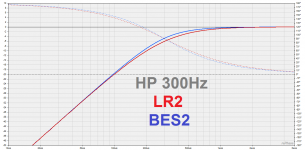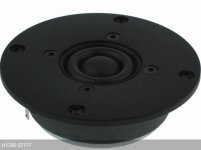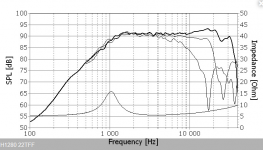No, you misunderstand. I am talking about the LP filter on the woofer. If you add notch filter above the LP knee then it is on the downward slope of the LP. The sum of the notch and the LP will be very steep at first then much shallower after the notch. The shallower part is not useful, so don't use it. This just leaves a steeper LP, with one or more less components (passively.)
I should have mentioned I had a notch as well  around 3.5 or 4Khz from memory. I still have it on the 4th order version of the crossover as well. The midbass units were a challenge, and certainly I suspect most people with experience (which I didn't have at the time) wouldn't even try to implement a 2nd order with them.
around 3.5 or 4Khz from memory. I still have it on the 4th order version of the crossover as well. The midbass units were a challenge, and certainly I suspect most people with experience (which I didn't have at the time) wouldn't even try to implement a 2nd order with them.
Tony.
Tony.
I do enjoy loudspeakers. Sufficiently easy to understand, sufficiently difficult to lead us into new ideas.
When we talk about multiway we are taliking about stuff like Troels Gravesen's 3-way Classic. Or a simple 5" plus 1" two way. Easy Peasy.
I also like my maths and quantum theory. Here's something (Group Delay) EVERYBODY glossed over:
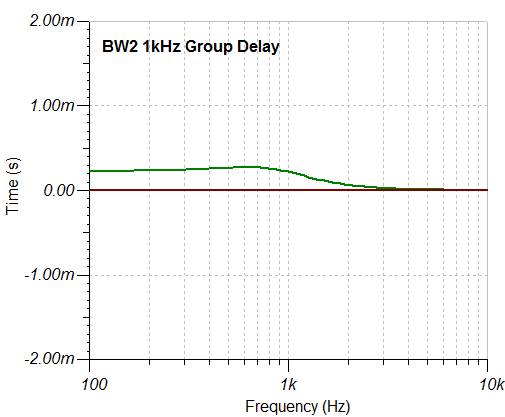
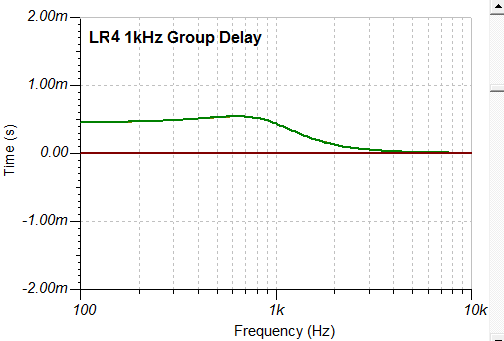
The relationship between Butterworth and Linkwitz-Riley. See, two BW2 cascaded makes a LR4! And it follows that two BW3 cascaded makes a LR6.
Interestingly it matters not one whit what you do to tweeter polarity, the group delay remains constant. So two wildly different impulse responses and frequency responses have the same group delay. It actually gets a bit like the quantum theory. The big question is always "What can you actually measure?"
It seems to me that you can measure as exactly as you like, but still be uncertain if the tweeter is on top or below the woofer, or what the polarity is.
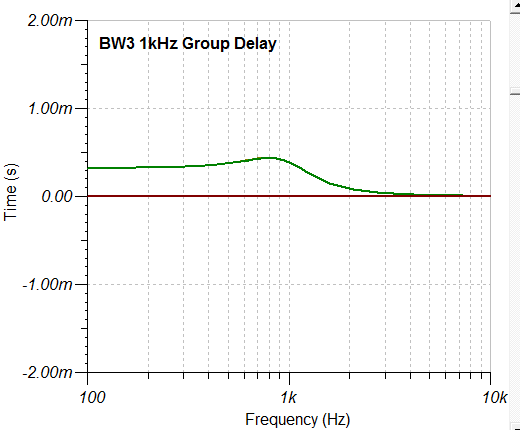
I am greatly enjoying taking speaker design into the quantum theory. For those of you living on a different planet with (HIGH-EFFICIENCY) horn tweeters or fullrange (FULLRANGE) drivers which are a very different discipline from MULTIWAY, I can only say loosen up a bit. But I seriously wonder why you hang around here. We do what we do.
Investigate the 4 states of mind. The Four States of Mind.
When we talk about multiway we are taliking about stuff like Troels Gravesen's 3-way Classic. Or a simple 5" plus 1" two way. Easy Peasy.
I also like my maths and quantum theory. Here's something (Group Delay) EVERYBODY glossed over:
The relationship between Butterworth and Linkwitz-Riley. See, two BW2 cascaded makes a LR4! And it follows that two BW3 cascaded makes a LR6.
Interestingly it matters not one whit what you do to tweeter polarity, the group delay remains constant. So two wildly different impulse responses and frequency responses have the same group delay. It actually gets a bit like the quantum theory. The big question is always "What can you actually measure?"
It seems to me that you can measure as exactly as you like, but still be uncertain if the tweeter is on top or below the woofer, or what the polarity is.
I am greatly enjoying taking speaker design into the quantum theory. For those of you living on a different planet with (HIGH-EFFICIENCY) horn tweeters or fullrange (FULLRANGE) drivers which are a very different discipline from MULTIWAY, I can only say loosen up a bit. But I seriously wonder why you hang around here. We do what we do.
Investigate the 4 states of mind. The Four States of Mind.
Last edited:
Awesome, lucky I can multitask.Steve said:if it’s worth continuing to read this chapter or if now is the time to have a cup of coffee
Don't you like high efficiency?
Do you have crossovers? I'd guess a discussion about shallow vs steep slopes would still apply.
I was particularly interested to read this:
I assume stepper should read: steeper
I don't see why this discussion shouldn't apply to speakers other than dome/woofer or dome/mid/woofer.
Even if my home speakers don't have any crossovers does not mean I would not be interested in discussions about other topologies. I'm particularly interested in what experiences people have with different slopes or topologies. Just to learn.
However I am not as surprised as Steve is about an IR looking different or having a tweeter polarity change while the group delay is still the same. I've spend way too much time learning the why to be surprised by that.
I was particularly interested to read this:
Hence, I use a shallow slope on the tweeter 6 dB/oct and a stepper one on the woofer 18dB/oct . Works just fine for me.
I assume stepper should read: steeper
I don't see why this discussion shouldn't apply to speakers other than dome/woofer or dome/mid/woofer.
Even if my home speakers don't have any crossovers does not mean I would not be interested in discussions about other topologies. I'm particularly interested in what experiences people have with different slopes or topologies. Just to learn.
However I am not as surprised as Steve is about an IR looking different or having a tweeter polarity change while the group delay is still the same. I've spend way too much time learning the why to be surprised by that.
I don't see why this discussion shouldn't apply to speakers other than dome/woofer or dome/mid/woofer.
I agree.
Thing is that its not necessarily high efficiency that I am seeking, it's constant and controlled directivity, a flat high DI. High efficiency seems to come along as a great benefit. No two or three way direct radiating speaker can have those features.
Last edited:
I don't see why this discussion shouldn't apply to speakers other than dome/woofer or dome/mid/woofer.
I agree,
and would take it further to say 'shallow vs steep' x-overs should probably be discussed on their own merits, without any speakers even involved, .....
....if we want a good foundation to discuss their application in different speaker designs / objectives.
I am greatly enjoying taking speaker design into the quantum theory. For those of you living on a different planet with (HIGH-EFFICIENCY) horn tweeters or fullrange (FULLRANGE) drivers which are a very different discipline from MULTIWAY, I can only say loosen up a bit. But I seriously wonder why you hang around here. We do what we do.
Are you planing to design speakers for robots?
group delay is the derivative (negative) of unwrapped phase vs frequency, so polarity won't have anything to do with it. Reverse polarity does nothing but move all the phase values by 180 degrees, the slopes don't change. But polarities will have a lot to do with how wavefronts from tweeters and woofers will combine, and the resulting group delay (and frequency response magnitude) of the combination.
.....I went with bessel originally because of the theoretical time domain advantages, and also because virtually no one else seems to (I like to tread the path less trodden). I think people tend to shy away from them because they don't sum completely flat like a LR.
Interestingly for whatever reason, I always find in simulation it is easier to get the drivers to match the bessel slope than a L/R one.
One interesting thing about the 2nd order bessel is that it is actually a steeper slope than a 2nd order L/R whereas with the 4th Order it is the opposite (ie L/R is steeper than bessel). So if you are worried about power handling with a 2nd order slope, a bessel may help somewhat.....
About 2nd order BESSEL agree they don't sum flat as 2nd order LR do, but don't agree it tax less on used driver. In my notes doing research in past to simulate 2nd order BESSEL slopes into Rephase/REW/XSim it reads take a LR2 slope and add a PEQ Q0,58/+1,3dB at frq of XO point and its now transferred to BES2 as seen below, can you agree this
Attachments
Hi Brytt, I think probably my wording was wrong. I said steeper slope, but when you look at your example, it is more a steeper knee. If you look at the LR4/BES4 the knee would be reversed, ie the bessel would be the one that starts rolling off earlier with a bigger overlap region between the drivers.
That's probably what I should have said, the overlap region of the drivers is narrower with the bessel compared to the LR with 2nd order. Some adjustment can be made (to the bessel) by using asymetric crossover points, provided it doesn't mess with phase too much, to get flatter summing. This is a good article on bessel filters used for crossovers A Bessel Filter Crossover, and Its Relation to Others
Tony.
That's probably what I should have said, the overlap region of the drivers is narrower with the bessel compared to the LR with 2nd order. Some adjustment can be made (to the bessel) by using asymetric crossover points, provided it doesn't mess with phase too much, to get flatter summing. This is a good article on bessel filters used for crossovers A Bessel Filter Crossover, and Its Relation to Others
Tony.
Member
Joined 2009
Paid Member
No, you misunderstand. I am talking about the LP filter on the woofer. If you add notch filter above the LP knee then it is on the downward slope of the LP. The sum of the notch and the LP will be very steep at first then much shallower after the notch. The shallower part is not useful, so don't use it. This just leaves a steeper LP, with one or more less components (passively.)
Ive wondered about this too. I thought there would be a need to retain a specific LP slope to keep the FR well behaved at the XO frequency which means its better to add a notch at a point abve XO point instead f steepening up the LP?
I suppose where I am coming from is that we take tremendous reliance on flat frequency response as being the measure of a good loudspeaker.
Well, it's not all there is to it. I've discovered that power response matters too. And flat impedance is a good thing to keep your amp happy. Dispersion is a factor also. And keep each driver in its comfort and low-distortion zone.
AFAIK, distortion is produced by excessive excursion and extremely non-linear high mechanical loss. It sounds like fuzz for the most part.
WLM produced the 8" plus 2" cone splendid WLM La Scala design:
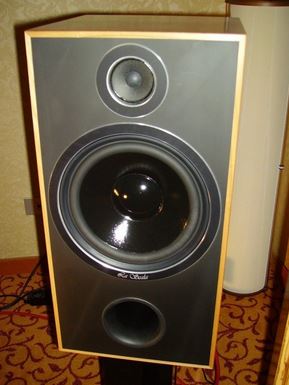
These are extremely cheap Visaton drivers which I happen to own. You take your chances on the filter. I would favour at least 18dB/octave at 3kHz. Or about 3rd order. It has its strengths. Cone tweeters can work very well without sounding overly bright.
What I wanted to talk about was the interaction between a driver and the filter. We know that two BW2 cascaded makes a LR4 response. So why not cascade a BW2 electrical tweeter filter with a near BW2 12dB/octave tweeter mechanical response? Which is LR4 acoustically.
The H1280-06 22TFF is an animal like this.
But, TBH, whatever I think of soft-domes, a 1kHz crossover is a bit low for a 3/4" tweeter. I wouldn't expect that to go loud in comfort. 3kHz would be more like it for the big orchestral pieces.
Well, it's not all there is to it. I've discovered that power response matters too. And flat impedance is a good thing to keep your amp happy. Dispersion is a factor also. And keep each driver in its comfort and low-distortion zone.
AFAIK, distortion is produced by excessive excursion and extremely non-linear high mechanical loss. It sounds like fuzz for the most part.
WLM produced the 8" plus 2" cone splendid WLM La Scala design:
These are extremely cheap Visaton drivers which I happen to own. You take your chances on the filter. I would favour at least 18dB/octave at 3kHz. Or about 3rd order. It has its strengths. Cone tweeters can work very well without sounding overly bright.
What I wanted to talk about was the interaction between a driver and the filter. We know that two BW2 cascaded makes a LR4 response. So why not cascade a BW2 electrical tweeter filter with a near BW2 12dB/octave tweeter mechanical response? Which is LR4 acoustically.
The H1280-06 22TFF is an animal like this.
But, TBH, whatever I think of soft-domes, a 1kHz crossover is a bit low for a 3/4" tweeter. I wouldn't expect that to go loud in comfort. 3kHz would be more like it for the big orchestral pieces.
Attachments
Last edited:
Isn't a flat power response a flat frequency response in the real world?I suppose where I am coming from is that we take tremendous reliance on flat frequency response as being the measure of a good loudspeaker.
Well, it's not all there is to it. I've discovered that power response matters too.
When we talk about multiway we are taliking about stuff like Troels Gravesen's 3-way Classic. Or a simple 5" plus 1" two way. Easy Peasy.
...
For those of you living on a different planet with (HIGH-EFFICIENCY) horn tweeters or fullrange (FULLRANGE) drivers which are a very different discipline from MULTIWAY, I can only say loosen up a bit. But I seriously wonder why you hang around here. We do what we do.
It might be "easy peasy" for you, but, honestly, that sounds to me like an unnecessarily restrictive conception of what a "Multi-Way" loudspeaker (which is what this forum "around here" really is about) must be.
Marco
- Status
- This old topic is closed. If you want to reopen this topic, contact a moderator using the "Report Post" button.
- Home
- Loudspeakers
- Multi-Way
- Well I suppose the shallow vs. steep argument will just go on and on
